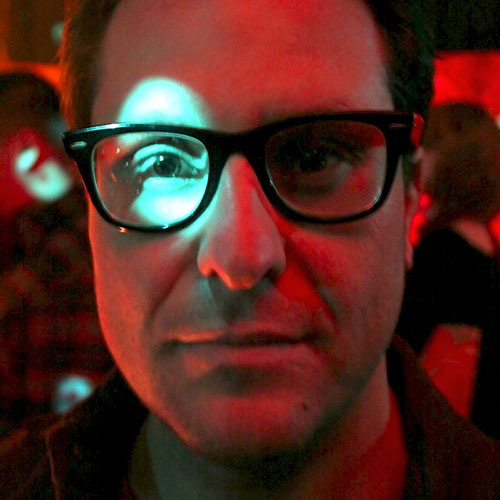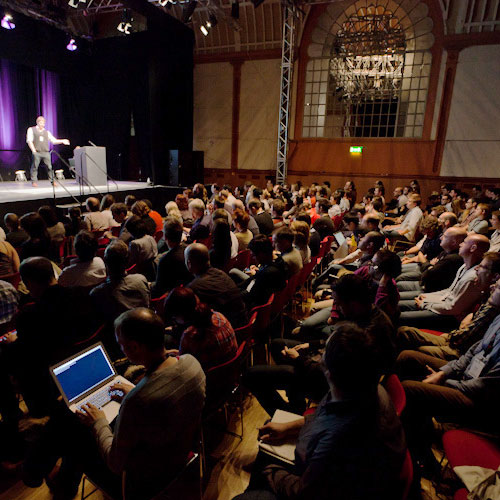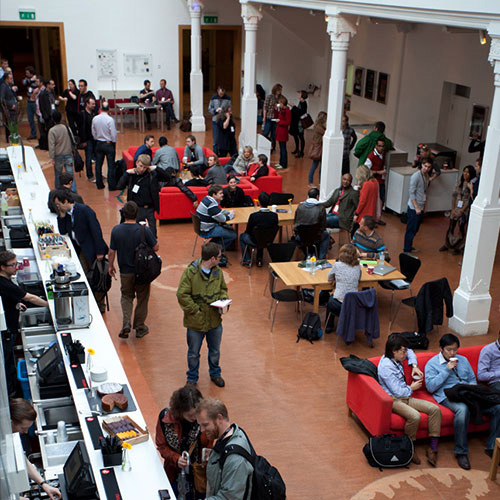
at The Corn Exchange, Brighton, UK
A mix of practical and theoretical, commercial and academic – the point of this year’s theme is that knowledge of the past informs us to create better products for the future.
Follow @uxbri on Twitter
To be absolutely frank, if marketers had a proper sense of proportion, they would spend a third of their time learning about usability and customer experience. But if, as is more likely, you only have a day to spare, then there are few better places to study the subject than here.
Rory Sutherland, Vice-Chairman, Ogilvy & Mather UK
Probably THE most exciting meeting I have been to in a long time
Robin Dunbar, Professor of Evolutionary Psychology and head of the Social Neuroscience Group, University of Oxford

For most of us who work on the Internet, it’s almost impossible to imagine a world without Web browsers, URLs and HTTP. But in the years leading up to Tim Berners-Lee’s world-changing invention, a few visionary information scientists were exploring alternative systems that often bore little resemblance to the Web as we know it today. While we might tend to think of the Web as a recent historical phenomenon, the heritage of hypertext actually stretches much further back than most of us might imagine, with conceptual roots in the so-called Second Industrial Revolution of the late nineteenth century.
The modern high-tech industry tends to deprecate earlier technologies. This is hardly surprising, when profits are predicated on a model of planned obsolescence. But if we take a close look at some of these earlier technologies, we can find plenty of provocative concepts that have yet to be fully realised. Some of these ideas may have life in them yet, especially as Internet-based software starts to evolve beyond the browser. Today, designers and developers are exploring all kinds of new interaction models beyond the traditional Web page metaphor: browser-less apps, gestural interfaces, and even mind-reading computers. As we enter this new era, what lessons might we learn from these alternative technological visions?
The presentation will focus on the pioneering work of early information scientists like Paul Otlet, Vannevar Bush, and Doug Engelbart, as well as later hypertext pioneers of the 1960s, 70s and 80s. In this presentation, Alex Wright will explore the heritage of these almost-forgotten systems, in search of promising ideas left by the historical wayside.
Alex Wright is the Director of User Experience and Product Research at The New York Times and the author of Glut: Mastering Information Through the Ages, hailed by the Los Angeles Times as “a penetrating and highly entertaining meditation on our information age and its historical roots.”
Alex has also led research and design projects for IBM, Microsoft, The Long Now Foundation, Harvard University, the Internet Archive, and Yahoo!, among others. His work has won numerous industry awards, including a Webby, Cool Site of the Year, the PRSA Silver Anvil and an American Graphic Design Award. He is currently a faculty member at the School of Visual Arts MFA program in Interaction Design.

Mark will examine what designers should consider when designing for very new user interfaces. He will draw on his experiences from working with the Kinect on Lionhead’s latest title, Fable: The Journey.
Mark Backler is a game designer at Lionhead Studios who has just finished working on Fable: The Journey. He has been in the games industry for 6 years and has also worked at Kuju and EA. Other games he has worked on include Harry Potter and the Order of the Phoenix, and Milo & Kate.

Neuroscience has changed over the last 5 years. Neuroheadsets (headsets that read brainwaves) became affordable and accessible. No longer confined the realm of professors with huge research budgets, neuroscience is accessible to everyone. In this session Guy will live demo a neuroheadset that reads brain waves and uses an API to allow recognition of facial expressions, emotions and cognitive thought – that is, the headset can read basic, deliberate conscious thought. Although the device is aimed at the gaming market, the potential for the physically impaired is considerable. Come and see the potential of today’s Brain Computer Interfaces.
Guy is an ASP Insider and an MVP in ASP.NET. He is the author of ".NET Internationalization" published by Addison-Wesley. He is a Microsoft Certified Professional developer, author, trainer and speaker, has spoken at many European and US conferences and is an INETA Speaker. He runs the .NET Developer Network, a free .NET user group in the South West of England. He co-organises DDD South West, a free one day technical event in the South West of England. He has written over 50 magazine articles and has co-authored an application development book. You can read his blog at guysmithferrier.com.

It’s clear that an amazing new category of product is emerging. Connected devices are already changing our lives but are they ready to be domesticated? Ben’s talk will explore a near future where our homes are shared with objects and devices that communicate and collaborate to enhance and enrich our lives and asks the question ‘Is Design enough?’.
Ben Bashford has a background in fine art, graphics and electronic music and has been designing and building stuff for the internet in some form or another since it was subculture. His focus is on the open, pervasive and social Internet - crafting products and services that combine networked technology with physical stuff.

Although Multi-touch devices have become common in the consumer world, users have sacrificed the tactile feedback afforded by physical buttons. The Bristol Interaction and Graphics group has been exploring various technical solutions to create the next generation of touch interfaces that support multi-point haptic feedback as well as dynamic allocation of views to different users. For example BIG recently presented a tabletop system where users can come together and view shared content or by leaning forward can get personalised views that are only visible from that particular view-point. This talk will present our recent research endeavours in this direction and present some design challenges.
Dr Sriram Subramanian is a Professor in the Computer Science department of the University of Bristol where he co-directs the interaction and graphics group. Prior to moving to Bristol he has worked in Canada for the University of Saskatchewan and in Netherlands for Philips research labs. His primary research interest is in Human-Computer Interaction with a particularly on emphasis on novel input devices and techniques. His research involves combining hardware electronics with design to create novel and engaging end-users experiences with computer mediated systems.
His most recent interests are in the design, implementation and evaluation of novel multi-view displays and multi-point haptic systems. More information is available at Bristol Interaction & Graphics

The ultimate goal of innovation is user adoption: we want people to actually use the things we create in a way that impacts their lives. But building the better mouse trap guarantees nothing. In fact, history shows it's not the whiz-bang of technology but rather human factors that matter in the end.
This is where UX designers come in. Through empathy and understanding of people's needs and perceptions, we can increase the rate of adoption. In this talk, Jim will look at some specific design-related considerations in successful innovation.
Jim Kalbach is Principal UX Designer with Citrix Online. He holds a degree in library and information science from Rutgers University, as well as a Master’s degree in music theory and composition.
Jim is an active speaker and instructor on user experience, usability, and information architecture. He helped found local UX groups in Hamburg, as well as organize conferences in Germany and Europe. Jim is the author of the book Designing Web Navigation (O’Reilly, August 2007). He blogs at experiencinginformation.com.

Picture a world where Amazon.com is a factory. Products are made as needed, based on direct input from users to designers and developers. Consumption directly drives production, and data informs design. If we weren't talking about physical products, this would sound a lot like Web/app interaction design, but the worlds of making atoms and bits are quickly colliding, and the implications are profound. By mapping what we have learned creating analytics-driven digital design to the physical world, we can change how everything is made, for the better.
As a consultant, designer, researcher, author, and entrepreneur focused on people’s relationship to digital tech, Mike has been involved in a wide variety of technology design and research projects since 1986.
In 2001, following his role as Senior Researcher at Wired Digital, Mike co-founded Adaptive Path. He is currently leading all design efforts at ThingM, a company he co-founded in 2006. Mike has worked with some of the most innovative and dynamic organisations in the world.

What is the relationship between interaction and thought? Consider how you would bake a cake. You’re in the kitchen and have the recipe on your iPad. You can read it without scrolling or even squinting. So why do you point at the screen? Why do you mutter that you need three cups of flour? Why do you arrange the ingredients on the table in a certain way? All the information you need is visible. All the ingredients are ready to hand. So why all these superfluous interactions? More importantly, why do we see these things in everything from baking a cake to playing Tetris to analysing data on sticky notes?
Deep interaction is the idea that how we interact with the world is tightly coupled to how we think. We interact to make meaning, develop understanding, and create insight. This does not happen just in our heads. We do not simply look at the world and think. Karl call’s this deep interaction because it involves a complex connection between mind, body, and world. Interaction is more than clicking pixels.
Karl will explore the contours of deep interaction and examine its implications as we move from a world of keyboards and mice to a world of touch, gesture, and beyond.
Karl Fast is a professor of User Experience Design at Kent State University. He studies how people interact with information as they try to make sense of their world. Especially in a digital world, where information is an abundant resource, and our interactive technologies are becoming more powerful and more nuanced. He studies how we think by interacting with our environment and what this means for designing the digital future.
Karl is a founding member of the Information Architecture Institute.

The after party will be at the Latest Music Bar
14-17 Manchester Street
Brighton
East Sussex
BN2 1TF
We have several sponsorship levels to suit every budget.
Download our sponsor pack or contact Emmeline


Originally the Prince Regent’s riding house, the Corn Exchange is a beautiful building in the heart of Brighton. You’ll find plenty of great places to eat, sleep and shop all within close proximity.
The Corn Exchange is accessible to delegates who are wheelchair users. It is also fitted with Infrared Hearing Assistance and traditional T Loops for those with hearing impairment. Please contact the venue to advance book units on 01273 261587.
Mike Kuniavsky photo – Cassidy Curtis
© UX Brighton 2012